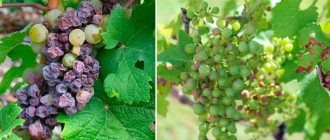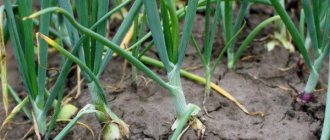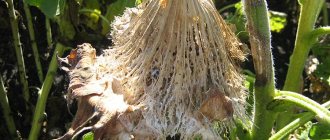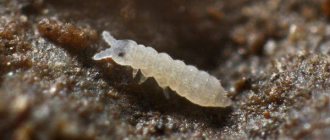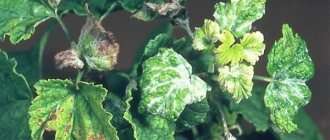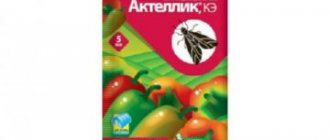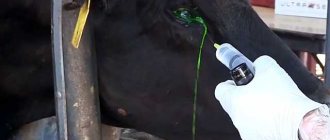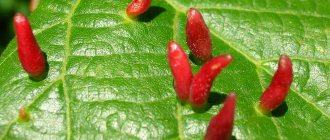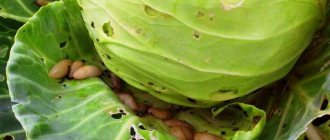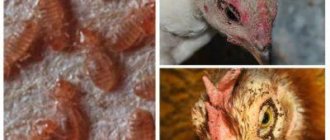Fruits and berries » Grapes
0
920
Article rating
Kira Stoletova
Grapes are affected by more than 75 species of mites. Common types include red greenhouse, leaf, grass, and garden. Grape mites are eliminated using a complex of chemical and traditional methods.
Fighting mites on grapes
Meet the felt mite, or itch
The grape mite is a harmful parasitic insect that lives wherever grapes grow. Found in Africa, North America, and Central and Southern Europe. During the wintering period it hides mainly in the bark (if there are cracks), in bud scales and in fallen leaves. In total, up to 1000 mites (mostly female) can live in one such affected kidney.
From the moment the buds swell and open, the grape itch moves to the leaves and begins to feed on plant sap. While eating, this insect secretes saliva, which contains a substance that helps accelerate cell growth and division. As a result, its enzymes, in direct contact with grape leaves, lead to deformation of the structure of the foliage. This structural disorder is displayed in the form of large and small oval-shaped bubble-shaped swellings that appear on the outside of the leaves.
On the inside of the foliage affected by the mite, a peculiar white coating appears, reminiscent of fluffy felt. Initially, this plaque is beige or white in color. Later they acquire a red and sometimes brown color.
What kind of pest is this?
The grape mite belongs to the class of arachnids, the superfamily of four-legged mites. It has the popular names itching, felt mite, spider mite, and multiplies quickly, although it does not live long.
The parasite can only be examined under a microscope. Its presence will be visible by some signs, although at first it can be confused with mildew:
- Curly leaves with burgundy tubercles.
- Young leaves are smaller.
- Starting in mid-summer, the green mass becomes gray-white.
- Yellowing or formation of necrotic spots on the leaves.
- Young shoots are stunted in growth and dry out.
A careful inspection should be carried out along the leaf veins on the inside and outside; these places are most attractive to the pest.
If females overwinter under the bark of grapes, in cracks or buds, then in the spring they begin to show their activity at a temperature of 5-10 ° C. Throughout the winter period, females and males adapt to survival without leaving offspring - such individuals are called “deutogynous.”
With the arrival of spring-summer, females lay inseminated and uninseminated eggs, which go through 4 stages of the life cycle and are called “protogynous”, actively reproducing throughout the warm season.
This type of parasite is most often transmitted with new grapes, during grafting, or carried by insects and wind. Mites climb into the bark for the winter on varieties with early ripening, and on others - into the buds.
What does grape itch look like?
It is almost impossible to see the itch well with the naked eye, since the grape felt mite is very small in size. Only with multiple magnification can you see that the tick’s body looks like a light or yellowish worm larva. The length of the female corresponds to 0.16-0.20 mm, and the male – 0.14 mm. The insect's abdomen has numerous small bristles at the front and rings with spines at the back and middle of the body.
A female tick can produce up to 7-12 generations of parasites during the year. Itch eggs have a transparent structure, oval shape and their size is 0.038 x 0.058 mm. You can find the eggs of the insect, as well as the insect itself, under swollen buds and under a white coating on the back of the affected leaves.
Signs of grape damage
Due to the small size of the pest, it cannot be seen on bushes. But there are certain signs by which infection can be determined.
When a mite sucks the juice from a plant, under the influence of saliva, convex tubercles, sometimes red-brown in color, appear on the outside of the leaf. At the same time, on the inside you can see a white cobweb, similar to felt. These small insects usually hide under the cobwebs. When the number of parasites increases, the cobwebs fill the entire inner part of the leaf, the islands of cobwebs seem to connect with each other and darken.
Felt mite on grapes
Lumps on the leaves can sometimes be confused with downy mildew. You can distinguish them in a simple way - run your finger along the surface of the sheet. If it is a fungus, the plaque will be easily wiped off.
Damage to the buds cannot be determined immediately; this becomes clear from undeveloped inflorescences. When the itch sucks the juice from the leaves and young shoots, it moves onto the grape clusters. Affected unripe berries become wrinkled and as if dried out, ripe fruits darken, acquiring a dark shade, and the entire bunch is entangled in a cobweb that looks like felt. When it rains, the grapes rot under this web, affecting neighboring grapes.
Why is itching dangerous for the grape harvest?
It is known that grape itch from the leaves is capable of moving to the young ovary, shoots and flowers of grapes. Consequently, other parts of the vine are also affected. If the affected areas of the grapes are not treated in a timely manner, this can lead to their death and a decrease in overall yield.
In addition, this type of mite is capable of transmitting viruses dangerous to grapes, which negatively affect the ripening of fruits, the condition of the root system, leaves, which can ultimately lead to the death of the grapevine.
Reviews
I have been using Actellik for several years now. A good insecticide at an affordable price. Previously, I tried to get by using traditional methods. But when there were too many ticks, I realized that drastic measures were needed and purchased this drug. It was possible to get rid of pests in one use.
My aunt has her own house in the Krasnodar region and grapes grow in her yard. One summer I was visiting there. Every day I watched her take care of her plantings. And one day I became an eyewitness to how grapes are treated against pests. Aunt grated a piece of laundry soap and dissolved it in water. The resulting solution was used to spray the bushes. And judging by the good grape harvest every year, this method of protecting against spider mites is working.
How to get ahead of affected grape leaves?
In order to find out if grape leaf mite has infected your plants in the garden, you need to pay attention to the leaves. In this case, it is worth looking at the back side of the foliage, since its front part at the first stage of infection does not have visual deformation in the form of tuberous mounds. However, a tick can be noticed by a secondary sign - the presence of a white terry coating on the underside of the leaf.
What harm do ticks cause?
The main food of insects is the sap of the plant. When the shoots begin to actively grow, the pest attaches itself to young leaves and shoots and sucks out the juice from them. At the same time, saliva contains an enzyme that causes deformation of plants. In places where the enzyme is injected, photosynthesis becomes difficult and cells begin to actively multiply, which leads to red-brown bumps appearing on the leaves.
The grape mite begins to suck the juice from the bottom of the vine, gradually moving upward, so most often the shoots that develop later than the others, that is, in late spring - early summer, remain intact.
Affected grape leaves
As a result of the “work” of the parasite, shoots, leaves and buds are affected, which leads to the fact that the inflorescences develop poorly, weaken, the grape clusters become small, and the growth of berries declines. In addition, affected bushes are more often susceptible to the proliferation of bacteria and fungi, which causes various plant diseases, such as powdery mildew. All this leads to large losses, sometimes up to 50-80% of the entire harvest.
What is it: itching or mildew?
The primary signs of mite infestation in grapes often coincide with the signs of other parasites. For example, itching can often be confused with mildew. Let us remember that this is a rather unpleasant and dangerous fungal disease for plants. According to preliminary information, it was accidentally brought to France from America in early 1878. From there it gradually spread to vineyards throughout Europe.
If you pay attention to grapes infected with mildew, leaf diseases of this type affect the upper and lower parts of them. On the surface of the foliage you can see characteristic yellowish spots the size of a penny or more. A clearly visible white fluff appears on the back of the leaves - this is a mycelium. It is because of this that inexperienced gardeners make the “wrong diagnosis”. How to determine whether it is itching or mold deposits?
You can determine the type of parasitic effect on a plant using simple steps. So, if you run your fingers over the white coating that has formed on the lower surface of the leaf and it rubs off, then you are most likely dealing with mildew. If such an action does not erase the fluff, then it is a grape mite. We will discuss methods of combating this parasite below.
Prevention measures
Preventive measures should begin with sanitizing the area:
- Constant cleansing of weeds and other diseased plants.
- Preventive spraying with Bi-58, a Bordeaux mixture, is used in spring and autumn.
- Proper care in compliance with all agricultural practices.
- Choice for grafting healthy plant varieties.
- Digging up the soil and spraying with insecticides.
- Regular inspection of the green mass of plants.
- In spring, summer and autumn, change treatment preparations so that the parasite cannot adapt to one treatment.
- It is impossible to process when the berries are ripe, and 20 days before harvest.
- The vine should not come into contact with the soil.
Diseased leaves are removed, and spraying is carried out in sunny weather in the evening or morning, always in accordance with the instructions.
The mite is a parasite that feeds on the contents of the cells of grape leaves, which negatively affects the number of berries set and their filling with sugars and ripening. On varieties with white and yellow berries it forms yellow tubercles, on red, pink, blue - brown tubercles, while the leaf blade may begin to curl at the edges. Timely measures to combat the pest can save crops and bushes from death.
How to distinguish grape itch from leaf phylloxera?
Grape itch is a parasite that can also be easily confused with phylloxera, or leaf aphids. Previously, it was brought from America, and first appeared in European vineyards. At the moment, aphids are selective about their own food and prefer to settle on the leaves of mainly Asian and European grape varieties. Thus, leaf phylloxera affects such grape varieties as White-Pink, Altai White, Damascus Rose, Dubinushka and others. Aphids can also appear on some American grape varieties. What do aphids and itching have in common?
In addition to the fact that the target of attack of both parasites is grapes, leaf diseases of this type have some other common features. For example, when affected by both itching and aphids, deformed areas similar to swellings or blisters can be seen on grape leaves. Such swellings are called galls. And it is in them that phylloxera larvae develop. In advanced cases, swellings form not only on the leaves, but also on the stems, cuttings, and tendrils.
Unlike aphids, itching forms smaller and sparse swellings. In phylloxera they are more frequent and larger, resembling blisters or warts. If desired, they can be crushed with force with your fingers.
Grape mite: control methods
In order to get rid of a tick, it is necessary to deal with it in a timely manner. However, the whole difficulty when baiting an insect lies in the fact that it settles on the back side of the leaf, and not on its surface. Therefore, using specialized chemicals, it is necessary to spray the foliage from the back. Experienced gardeners recommend using colloidal sulfur for this purpose.
For this you will need approximately 10-50 g of sulfur. You can also use drugs against grape mites such as Fufanon, Neoron, Karbofos, Tiovit-Jet, Fiori, Talstar, Kinmiks, Omite, Vertimek, Actellik " and others.
In addition, not yet opened buds must be sprayed with a solution of Nitrophen diluted in water, taking into account 200 g of the chemical per bucket of water. Next, it is recommended to treat the blooming buds. It is best to do this at the time of pulling out the kidneys. At this very time they reach a length of approximately 4-6 cm. It is recommended to treat them with a sulfur solution. It is prepared at the rate of 100 g of substance per bucket of water.
Application of traditional methods
Most often, the fight against these parasites begins with traditional methods, since they are safer and more gentle.
The most effective include:
- Onion peel. An infusion is prepared from it, which is used in the fight against many types of parasites and pests, including spider mites. For infusion, you need to fill the husk with clean water and leave for 3 days, after which you can spray the leaves and trunk.
- Marigold. It is a natural repellent that is highly effective. You need to take about half a bucket of inflorescences (dry) and fill with warm water (10 liters). Leave for 48 hours, apply to the plant in the evening.
- Colloidal sulfur. A 75% solution is used for processing. This method is quite popular and effective, but when using it you will need to adhere to some rules. The plant should be sprayed in hot and dry weather, otherwise the maximum result will not be achieved.
- Laundry soap. This remedy is familiar to many gardeners, as it is very often used against pests. For 10 liters of water you need to add 50 grams. soap, first crush or grate until it completely dissolves. This method can be used at any stage of plant growth.
What pests are dangerous to grapes?
In addition to such a parasite as the grape mite (we described the methods of combating it above), you can also find other pests in the garden. One of the most disgusting and unpleasant insects is the leaf beetle, or grape flea beetle. It is dangerous because, in addition to grapes, it is not averse to profiting from other plants.
Visually, it looks like a miniature cockroach, black in color and with a body length of no more than 3-4.4 mm. Oviparous. The eggs are laid by the female beetle and attached to 10-30 pieces on the inside of the leaf.
The fight against leaf beetle, like the fight against grape itch, is associated with the treatment of plant buds with special insecticidal solutions. For example, Fufanon and Iskra are used for this purpose.
The second harmful parasite resembles a butterfly - the grape leaf miner. It is capable of producing up to two or three generations per season. It feeds mainly on leaves, on which, like other pests, it lays eggs. Small caterpillars later crawl out of the eggs, crawl around the entire perimeter of the leaf and, in the process of their movement, make elongated passages in it, called mines. To eliminate moths, systemic insecticides are usually used. For example, it could be Confidor.
Another well-known insect pest is the grape gnat. Its size is only 2 mm. The mosquito itself is not harmful. Its larvae cause great harm. An adult insect is capable of laying up to 100 eggs at a time. After about 9-10 days, larvae emerge from them and begin to greedily eat the grape leaves. Wart-like swellings form in the areas where the larva lives. You can also get rid of mosquitoes using insecticides.
In addition, other pests can be found on the leaves, stems and roots of grapes, for example, weevils, borers, leaf rollers, mites, thrips, scale insects and cicadas.
Using anti-mite drugs on grapes
There are a variety of drugs available on the market today to combat felt mites, but not all of them are highly effective. First of all, gardeners should pay attention to the following types of compositions, be sure to pay attention to their description and method of application.
"Omite"
Insecticide-acaricide "Omite" is a Russian-made product of contact action, designed to effectively combat different types of mites on grapes, apple trees, black currants, potato tubers, and various vegetable crops grown in closed and open ground. It is supplied in the form of an aqueous suspension placed in a glass container with a volume of 0.0125 liters. The drug has a detrimental effect on the mobile stages of mites, with partial damage to the eggs of the pest's summer clutch. The most effective is fine-drop treatment of affected grapes, with the addition of an adhesive to the working solution (you can use finely chopped laundry soap).
The consumption rate of Omaita is 12.5 ml per 8–10 liters of water, and its shelf life in a closed container is 36 months. The diluted drug must be used as soon as possible. In addition to its high efficiency, it has a reduced toxic effect on bees, birds, fish and warm-blooded animals, which only adds to its advantages.
Important! It is better to apply insecticide on a clear, sunny day, in windless, hot weather.
"Vertimek"
This insecticidal-acricidal agent has a pronounced enteric-contact effect on garden pests. The drug is supplied as an emulsion concentrate, in bottles from 100 g to 1 l, which is diluted in water before use. "Vertimek" is effective in treating grapes against thrips, mites and apple borer, possibly as part of the use of anti-resistant programs.
The absorption of the drug into the plant tissue occurs already 2 hours after treatment of the grape bushes, and the duration of the protective effect lasts up to 4 weeks. This allows you to reduce the number of treatments per season. "Vertimek" belongs to the second class of danger for humans and the first class for bees, therefore it is characterized by a low toxic effect on them. However, it is prohibited to use it in the water protection zone of reservoirs. The consumption rate of the composition when processing grapes is 0.75–1 l/ha, shelf life is 4 years from the date of manufacture, but only if the container has not been opened.
"Fufanon"
The insecticide "Fufanon" belongs to the group of non-systemic organophosphorus compounds and is considered one of the most effective drugs in the fight not only against felt mites on grapes, but also against other gnawing, sucking insects from the class of Homoptera, Coleoptera, Lepidoptera, Diptera and mites on most fruit and field crops. The product is characterized by a pronounced contact-intestinal and fumigant effect on the pest, leading to its death within 2-3 hours after consuming the treated parts of the grapes.
We recommend reading the description and features of the fight against phylloxera.
“Fufanon” is supplied in the form of a concentrated emulsion in 5 liter canisters, and before use it is diluted in clean water. The consumption rate of the working solution is 2–5 liters per grape bush, with mandatory consideration of its age and type of formation. For greater efficiency, plants are sprayed twice, with an interval of 28 days. The shelf life of the drug in a closed container is 4 years from the date of manufacture indicated on the package.
"Bi-58"
This product is used to treat a wide variety of crops, allowing you to get rid of felt and spider mites, aphids, copperheads, caterpillars, leaf rollers, sawflies, scale insects and even mole crickets. Produced in the form of an emulsion concentrate, it simultaneously has a contact and systemic effect on the body of the insect pest, largely due to the main active ingredient dimethoate.
In addition to grapes, “Bi-58” can be used for spraying plums, pears, apple trees, vegetable crops and even herbs (for example, alfalfa). The constituent components of the drug are quickly absorbed into the plant tissue and spread throughout its entire body, having a negative effect on the insect’s body already in the first hours after eating the treated parts of the grapes. The protective effect lasts up to 4 weeks, both at low and high air temperatures.
The working solution is prepared by mixing 10 ml of concentrated substance (supplied in 5 ml ampoules) and 10 liters of water. Spraying of plants is carried out during the growing season, using 1.1–2.8 liters of ready-made diluted preparation per 1 hectare of plantings. Mechanized tillage of the soil under the vineyards can be carried out 4 days after spraying, and manual work - after 10. The maximum shelf life of the drug in the original and unopened container is 2 years, but it is advisable to use the already prepared working solution on the first day.
Video: Spraying the garden with BI-58
"Aktellik"
“Aktellik” is one of the most popular insecticides-acaricides with enteric contact action today, having a high degree of impact on various types of mites and other pests of garden crops: for example, aphids, thrips, scale insects, whiteflies, moths, weevils, fungus gnats , cabbage cutworm and codling moth. The main active ingredient of this Swiss composition is pirimiphos-methyl, at a concentration of 500 g per 1 liter. It is part of the organophosphate group of pesticides, which explains its contact-intestinal effect: disruption of the enzyme acetylcholinesterase and the complex biochemical processes of acetylcholine metabolism. The fumigant effect of the drug increases in a warm and humid environment, when the air warms up above +15 ° C, however, at values above +28 ° C it is better to postpone spraying the grape bushes. The protective effect of the drug lasts for 10–12 days from the moment of its use in closed soil and 3–10 days in open soil.
If necessary, Actellik can be mixed with other types of insecticides, but only if the reaction of the finished working solution is neutral (the product cannot be combined with other alkaline preparations or Bordeaux mixture). Both alone and in combination with other substances, the described insecticide has high resistance to inert surfaces.
Did you know? Long before the advent of classical chemical insecticidal drugs, humanity used their plant analogues. Thus, dried chamomile flowers were used for these purposes back in Ancient China, and then in the Middle Ages in Persia.
The drug is supplied by the manufacturer in the form of a concentrate placed in 2 ml ampoules. Before use, it must be diluted in 2 liters of clean water, and in case of a large concentration of pests, it is allowed to combine the contents of one ampoule with 1 liter of water. The prepared working mixture cannot be stored and must be used within the first day after preparation. Spray the grape bushes using standard sprayers, choosing only dry and windless weather for the procedure. In one season, no more than two treatments are carried out with an interval of at least two weeks.
Actellik is characterized by moderate toxicity to humans and animals (second class of hazard), but poses an increased danger to honey-bearing insects and fish. Do not process crops near water bodies or use the drug on flowering plants. After completing the treatment, hands and face should be washed thoroughly with soap. The shelf life of unopened packaging with insecticide is 3 years from the date of production. It is recommended to burn the remaining container after use or bury it away from water bodies.
